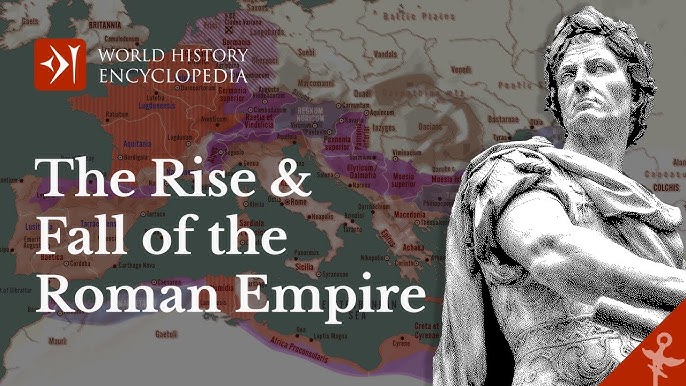
The Rise and Fall of the Roman Empire: The Roman Empire, one of the most influential civilizations in history, spanned over a thousand years, from its humble beginnings as a city-state to becoming the dominant power in the Mediterranean world and beyond. Its expansion, military prowess, political structures, and cultural achievements reshaped the ancient world and left an enduring legacy in law, governance, architecture, and language. Yet, despite its vast achievements, the Roman Empire ultimately faced internal and external pressures that led to its decline and fall. This examination delves into the rise, golden age, and fall of the Roman Empire, analyzing its growth, achievements, challenges, and the factors that contributed to its demise.
The Rise of the Roman Empire
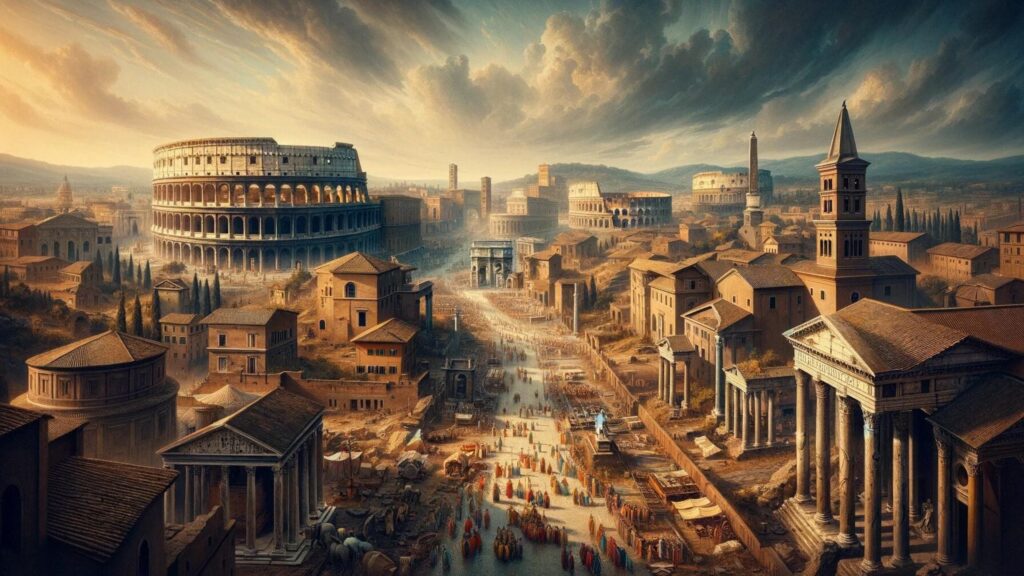

Origins of Rome
The origins of Rome date back to the 8th century BCE, with the legendary founding of the city in 753 BCE by Romulus and Remus, twin brothers raised by a she-wolf. According to legend, Rome’s early development was marked by kingship, but after the overthrow of the last king, Tarquin the Proud, in 509 BCE, Rome became a Republic. This shift led to a new system of governance based on elected officials, including consuls, senators, and tribunes. The Roman Republic would lay the foundation for Rome’s eventual imperial dominance.
Expansion and Conquest
Rome’s early expansion was fueled by its military prowess and strategic alliances. Over several centuries, it grew from a small city-state into a dominant power in the Italian Peninsula. The Republic’s early conquests, such as the Samnite Wars (343–290 BCE), and its conflict with Carthage in the Punic Wars (264–146 BCE), were crucial in establishing Rome as a major military power. Rome’s victory in the Second Punic War, marked by the famous general Hannibal‘s invasion of Italy, solidified Roman supremacy over the Mediterranean.
Rome’s territorial expansion continued, with conquests in Gaul (modern-day France), Spain, and parts of Germany and the Middle East. By the end of the 2nd century BCE, Rome controlled vast swaths of land across the Mediterranean, becoming the dominant empire of the ancient world.
The Transition from Republic to Empire
As Rome expanded, so did its internal conflicts. The Roman Republic began to face severe political instability, marked by power struggles between the Patricians (aristocratic families) and Plebeians (commoners). Military leaders like Julius Caesar, Pompey, and Crassus rose to prominence during the First Triumvirate (60–53 BCE). However, Caesar’s growing power led to a civil war with Pompey, culminating in Caesar becoming the dictator in 49 BCE. His assassination in 44 BCE set the stage for the rise of his grandnephew and adopted son, Octavian (later Augustus), who defeated his rivals and became the first Roman emperor in 27 BCE.
The Roman Empire was born out of this transition from republic to autocracy, with Augustus establishing the Principate, which maintained the appearance of republican governance but concentrated real power in the hands of the emperor. Augustus’s reign marked the beginning of a new era in Roman history, characterized by peace, prosperity, and consolidation.
The Golden Age of ROE


The Pax Romana
The reign of Augustus (27 BCE–14 CE) is considered the beginning of the Pax Romana (Roman Peace), a period of stability and prosperity that lasted for over 200 years. The Pax Romana was marked by significant advancements in infrastructure, law, and governance. Augustus instituted reforms that strengthened the empire’s military, secured its borders, and stabilized its economy. He also undertook massive public works projects, including roads, bridges, and aqueducts, that helped integrate the vast empire.
Military and Administrative Strength
The Roman Empire’s strength lay in its well-organized military, which was divided into legions, each consisting of around 5,000 soldiers. These legions were the backbone of Roman expansion and defense, ensuring the empire’s borders remained secure. Roman legions were trained to be highly disciplined and capable of waging war across diverse environments. Roman soldiers were also responsible for maintaining the empire’s infrastructure, such as building roads, fortifications, and public facilities.
Administratively, Rome’s system was characterized by a combination of centralized imperial control and local governance. Provinces were governed by senators, proconsuls, or prefects, and a network of roads and messenger systems helped maintain communication across the vast empire. Roman law, including the famous Twelve Tables, became a foundation for legal systems in Europe and beyond.
Roman Culture and Achievements
Culturally, Rome was a melting pot of Greek, Egyptian, and local influences. Roman architecture reached new heights with the construction of monumental buildings like the Colosseum, Pantheon, and Forum Romanum. Roman engineering feats, including advanced aqueducts, roads, and sewer systems, showcased their expertise.
Roman society also saw the development of Roman literature, philosophy, and arts. Virgil’s Aeneid, Ovid’s Metamorphoses, and the works of Cicero shaped Western literature and thought. Roman law, particularly the concept of natural law, became a lasting legacy influencing modern legal systems.
The Decline and Fall of the Roman Empire
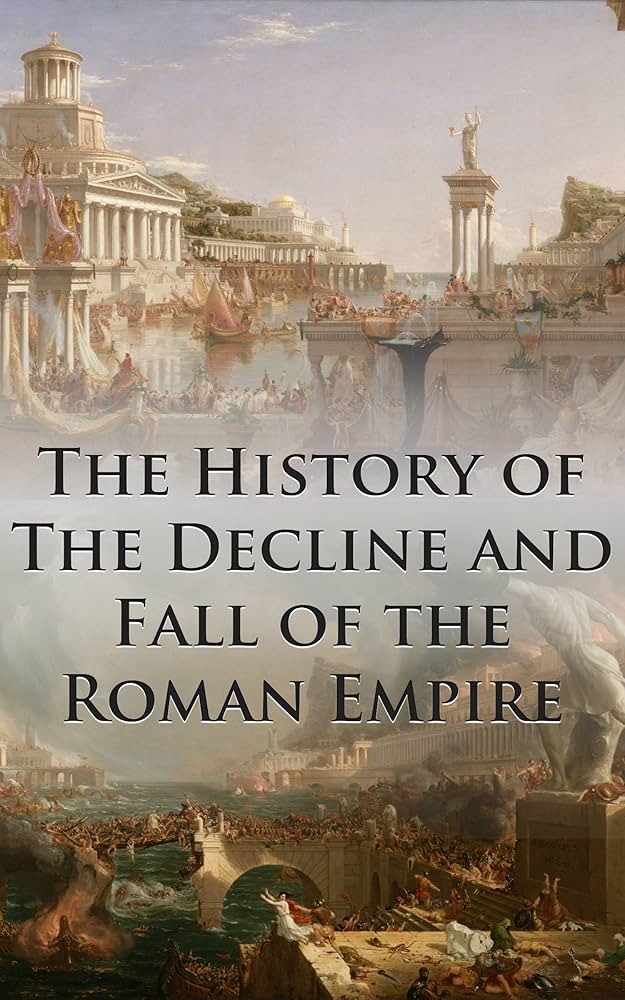

Internal Factors Contributing to Decline
As Rome reached its zenith, several internal factors began to erode its stability:
Political Instability:
After the reign of Marcus Aurelius (161–180 CE), a series of ineffective and corrupt emperors led to political instability. The Crisis of the Third Century (235–284 CE) was marked by civil wars, economic collapse, and foreign invasions. The empire was split into competing factions, and numerous emperors were murdered in quick succession.
Economic Decline:
Rome’s economy began to suffer from over-reliance on slave labor, high taxes, inflation, and a devaluation of currency. The empire’s vast size made it difficult to manage resources efficiently. Military expenditures also strained the economy as Rome attempted to defend its borders from invaders.
Over expansion:
The empire’s vast territorial extent proved to be both a strength and a weakness. The Roman military, stretched thin defending far-flung borders, could not maintain control over its frontiers. Barbarian invasions and internal rebellion became more frequent.
Barbarian Invasions and the Fall of the Western Roman Empire
The Barbarian invasions of the 4th and 5th centuries were a critical factor in the fall of the Western Roman Empire. Visigoths, led by Alaric, sacked Rome in 410 CE, and in 476 CE, the last Roman emperor, Romulus Augustulus, was deposed by the Germanic chieftain Odoacer, marking the official fall of the Western Roman Empire.
Other groups, such as the Huns, Vandals, Ostrogoths, and Franks, continued to encroach on Roman territories, gradually eroding Rome’s power. The Western Empire’s decay was accelerated by these invasions, along with internal divisions that weakened the central government.
The Division of the Empire
The division of the empire into two parts in 395 CE further weakened the Western Roman Empire. The Eastern Roman Empire, known as the Byzantine Empire, continued to thrive for another thousand years, preserving Roman culture and law. However, the West fell into decline due to a combination of internal strife, economic hardship, and external pressures.
The Legacy of the Roman Empire
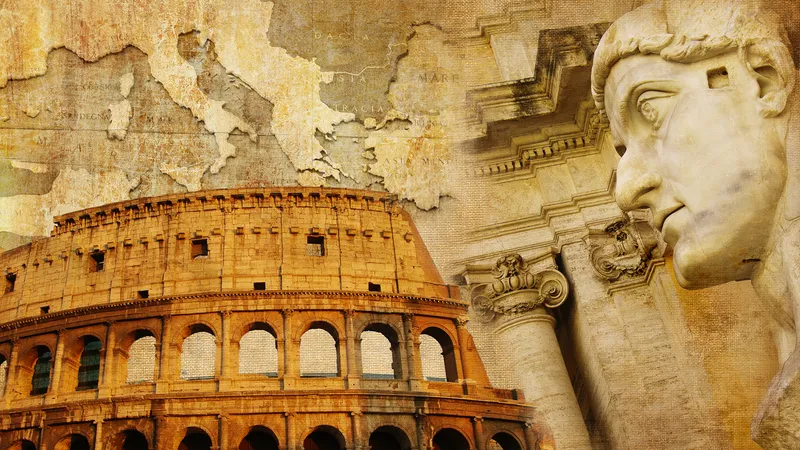
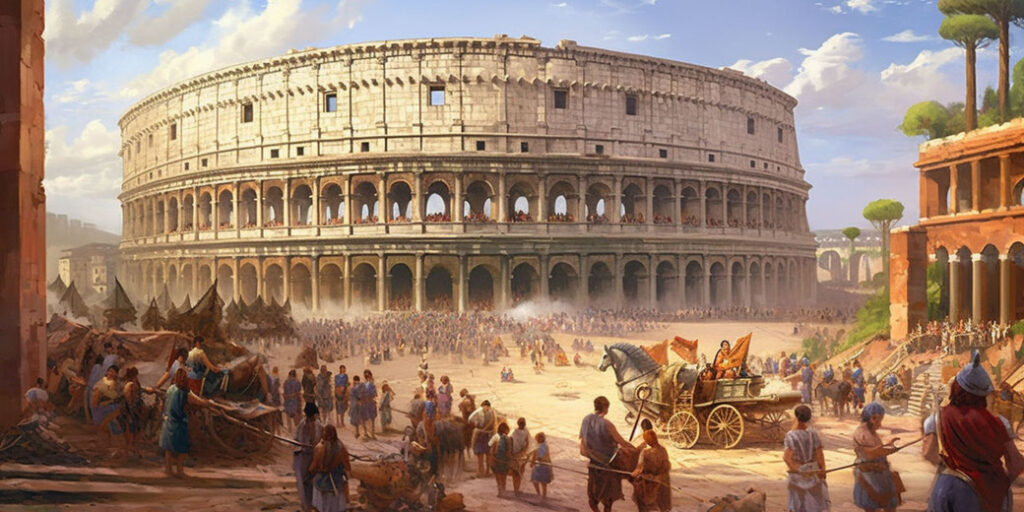
Despite its fall, the legacy of the Roman Empire endures in many aspects of modern civilization. The Roman Catholic Church became a powerful institution in Europe, carrying forward Roman traditions and governance. Roman law, language (Latin), and architectural styles influenced the development of European cultures, and the notion of a republic and citizenship continues to inform modern democratic systems. The Byzantine Empire, with its capital in Constantinople, preserved and transmitted much of Roman knowledge and culture, ensuring that Roman influence persisted well into the Middle Ages.
Cultural and Technological Achievements of Rome

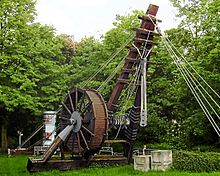
The cultural and technological accomplishments of Rome were among the most advanced of the ancient world and have continued to shape civilizations throughout history.
Roman Architecture and Engineering
Roman engineering and architecture are among the most visible legacies of the Empire. Romans mastered the use of the arch, vault, and dome, which allowed them to build large, durable structures. This innovation led to the construction of iconic buildings such as:
The Colosseum in Rome, capable of seating up to 50,000 spectators, was used for gladiatorial games, public spectacles, and other entertainment.
The Pantheon, with its massive unreinforced concrete dome, remains the largest dome in the world to this day.
The Roman aqueducts were engineering marvels that provided water to cities across the empire, including Rome itself, which could sustain over a million people at its peak. The use of concrete allowed for durable and efficient construction of vast infrastructure.
Roman road networks spanned over 250,000 miles, connecting distant parts of the empire and allowing for the quick movement of soldiers, merchants, and information. These roads played a critical role in the empire’s military control and economic prosperity.
Roman Art and Sculpture
Roman art was heavily influenced by Greek culture but developed its own distinctive characteristics. Romans were especially skilled in portraiture, creating realistic busts and statues of individuals, which reflected the importance placed on individual achievement and personal legacy. Roman sculptures were typically more focused on realism and depicting public figures, including emperors and generals, rather than idealized forms as in Greek art.
In terms of mosaic art, Romans used small pieces of glass or stone to create intricate designs for floors and walls, which adorned homes, temples, and public buildings.
Roman Literature and Philosophy
Roman literature drew heavily from Greek influences but developed its own literary traditions. The works of Virgil, especially the epic Aeneid, sought to promote Roman ideals and glorify Rome’s founding. Ovid, with his Metamorphoses, contributed to mythology, while Cicero provided critical writings on rhetoric, law, and philosophy.
Roman philosophy was influenced by Greek schools of thought, particularly Stoicism and Epicureanism, and played a central role in the moral and ethical education of Roman citizens. Seneca, Epictetus, and Marcus Aurelius were significant proponents of Stoic philosophy, emphasizing personal virtue and self-control.
Political and Administrative Systems


The Roman Empire’s success in governance was grounded in its ability to adapt and improve its political and administrative systems over time.
Roman Republic Governance
Initially, Rome was a republic with elected officials, and the Senate played a central role in decision-making. The Consuls, who served as the chief executives, were elected for one-year terms, and power was balanced between different political bodies. The Cursus Honorum was the sequential order of public offices held by politicians, ensuring that no individual held excessive power for too long.
The Senate, originally composed of elite aristocrats (Patricians), later incorporated Plebeians, creating a more inclusive system, albeit still skewed in favor of the wealthy class. However, as Rome expanded, the Republican political system began to struggle under the weight of increasing military power and social inequality.
Roman Imperial Governance
With the transition from the Republic to the Empire under Augustus, the system of government shifted from a republic with a Senate to an imperial bureaucracy. Augustus instituted reforms that stabilized the empire and instituted a system of provincial governance. The provinces were managed by governors appointed by the emperor, and these provinces were often divided into senatorial and imperial provinces, depending on whether they were peaceful or had military significance.
The emperor held supreme authority, both in political and military matters. Emperors often used their titles, such as Pontifex Maximus (high priest) and Princeps (first citizen), to consolidate power and portray themselves as guardians of the Roman state. The Roman civil service, staffed by administrators and bureaucrats, became more organized, leading to an efficient government system that could manage such a vast empire.
Roman Law
One of Rome’s greatest achievements was its legal system, which laid the foundation for much of Western legal thought. The Twelve Tables, a written code of law, was established in the mid-5th century BCE and served as the foundation for Roman law. Over time, Roman law evolved into a highly sophisticated system that emphasized the rights of individuals and the role of the state in enforcing laws. Concepts such as due process, innocent until proven guilty, and the right to a trial were rooted in Roman legal thought.
The Corpus Juris Civilis, compiled under Emperor Justinian in the 6th century CE, became the foundation for legal systems in many European countries and influenced legal codes in the modern world.
The Fall of the Western Roman Empire
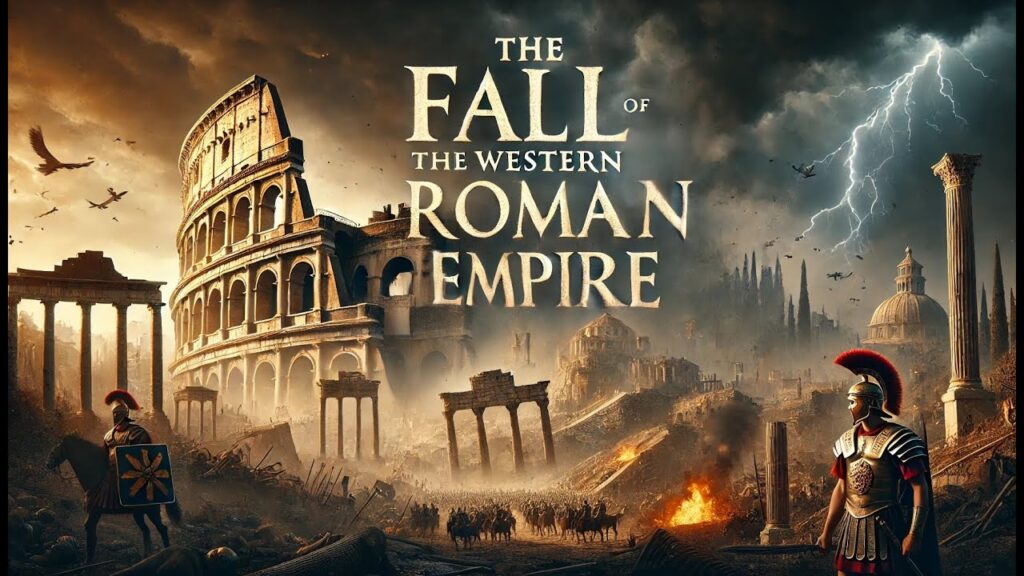
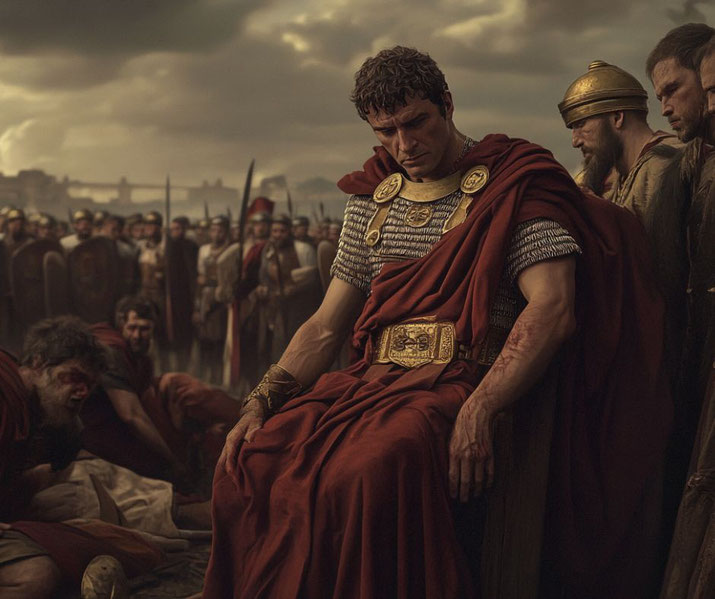
Decline in the 3rd Century
From the 3rd century CE, the Roman Empire began to experience significant internal instability. The Crisis of the Third Century (235–284 CE) saw a series of short-reigned and ineffective emperors, along with military anarchy, economic collapse, and frequent invasions by Germanic tribes, Persians, and other external forces. The empire’s territorial control began to weaken, and many regions experienced fragmentation, with usurpers and regional military commanders vying for power.
Division of the Empire
Emperor Diocletian (reigned 284–305 CE) attempted to address these crises by dividing the empire into Eastern and Western halves in 285 CE. This division created the Eastern Roman Empire (later known as the Byzantine Empire) and the Western Roman Empire, with separate emperors ruling each part. While the Eastern Empire continued to thrive, the Western Empire’s resources were stretched thin, and it was more vulnerable to invasions.
Barbarian Invasions and the Final Fall
The final blows to the Western Roman Empire came in the form of barbarian invasions. The Visigoths, led by Alaric, sacked Rome in 410 CE, and in 455 CE, the Vandals did the same. By the mid-5th century, Huns, Franks, Anglo-Saxons, and other tribes systematically infiltrated Roman territory. In 476 CE, the last Roman emperor in the West, Romulus Augustulus, was deposed by the Germanic leader Odoacer, marking the conventional end of the Western Roman Empire.
The Enduring Legacy of Rome
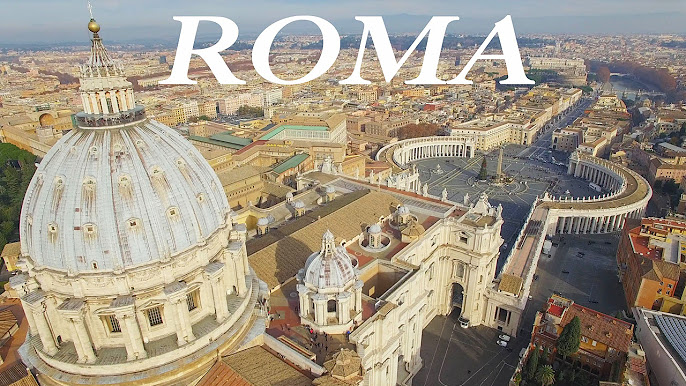
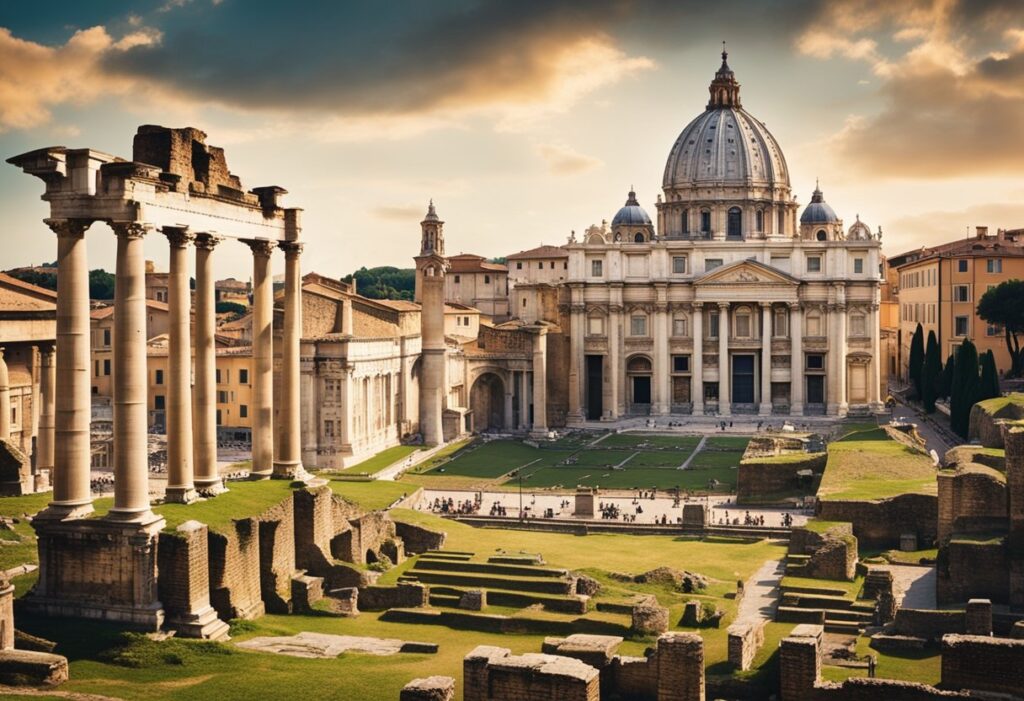
The Byzantine Empire, the continuation of the Eastern Roman Empire, managed to preserve Roman culture, laws, and institutions for nearly another thousand years until its fall in 1453 CE. In the West, the Roman Catholic Church became the central unifying force in Europe during the Middle Ages, often filling the vacuum left by the political collapse of the Roman Empire.
Roman culture, including its art, language (Latin), and philosophy, had a profound influence on the Renaissance and continued to shape Western civilization. The Roman law system is still the foundation of many modern legal systems, and the Roman architectural and engineering innovations influenced construction techniques throughout history.
Conclusion
The rise and fall of the Roman Empire serves as a powerful reminder of the complexities of power, governance, and empire-building. From its origins as a small city-state, Rome grew into a vast empire that dominated the Mediterranean, achieving remarkable successes in law, culture, and engineering. However, its decline was a gradual process, driven by internal weaknesses, economic challenges, and external pressures. While the fall of Rome in the West marked the end of an era, its influence persisted through the Byzantine Empire, the Roman Catholic Church, and the lasting impact of Roman culture and ideas on Western civilization. The story of Rome, from its ascent as a city-state to its decline as an empire, offers both a model of achievement and a cautionary tale, underscoring the complexities of sustaining power, stability, and cohesion in an ever-expanding world.


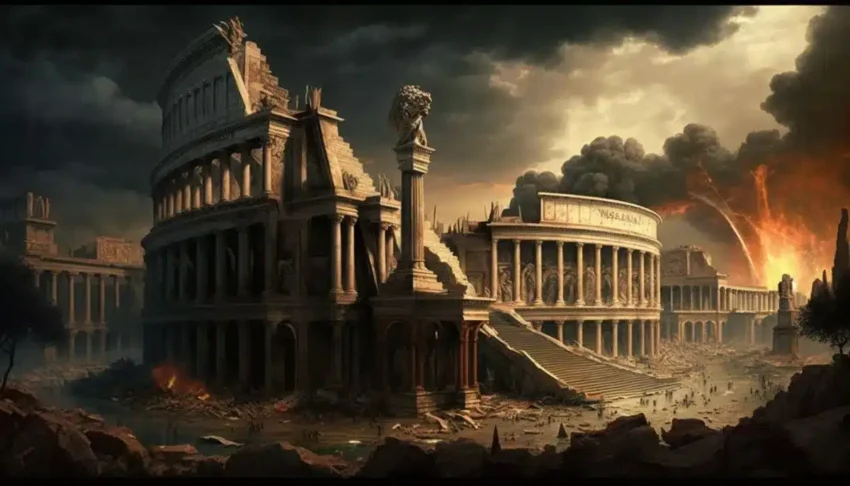
2 thoughts on “THE RISE AND FALL OF THE ROMAN EMPIRE”